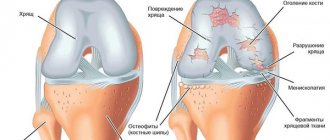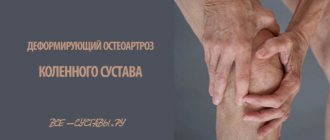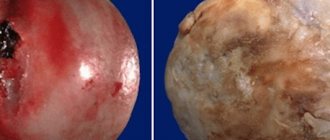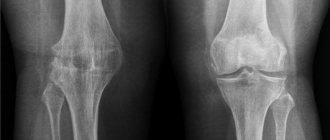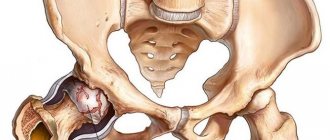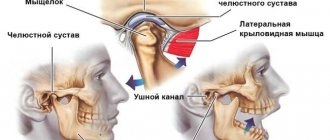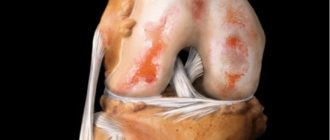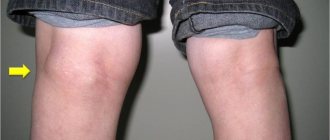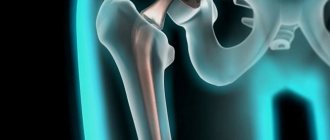The most loaded joint in the human body is the knee. That is why he suffers from various diseases more often than others. Arthrosis of the knee joint 1st degree (gonarthrosis 1st degree) is a progressive pathology of a destructive nature. Without appropriate treatment, the disease can lead to complete immobility of the limb, as the joint is usually completely destroyed or fused (ankylosis).
Reasons for the development of pathology
Gonarthrosis of the knee joint can be caused by the following factors:
- Severe wear of cartilage tissue. This occurs due to severe stress, for example, obesity, due to deformation of the musculoskeletal system (congenital or acquired).
- Deformation of the cartilage of the knee joint due to an infectious disease or inflammatory process (bursitis, arthritis).
- Trauma or postoperative complications.
- Disruption of metabolic processes in the body or in a joint, in particular.
Diagnosis of first-degree gonarthrosis involves finding out the exact cause of the disease, which will allow prescribing adequate and effective treatment.
Diagnostics
Despite the fact that gonarthrosis cannot be completely cured, therapy should be carried out only after a thorough diagnosis. It provides for the following actions:
- External examination of the knee joint.
- Description of symptoms by the patient and collection of anamnesis.
- X-ray of the knee joint, which allows you to make an accurate diagnosis. In the picture you can see a narrowing of the joint space.
X-ray image of knee arthrosis of varying degrees: a) first; b) second; c) third degree.
Symptoms
Knee arthrosis of the 1st degree develops gradually. So, the first to appear are mild nagging pains in the knee when running, fast walking or climbing stairs. Soreness often has a “starting” character: i.e. appears when movements begin, but weakens or disappears completely during significant activity.
Sometimes slight swelling appears above the knee; redness and warming of the skin are rarely detected. Subjectively, patients feel stiffness, which is often compared to a “cover on the knee.”
In some cases, already at the first stage, inflammation of the articular membrane – synovitis – may develop. The latter appears against a background of weakened immunity and infection of the body.
Thus, the noted symptoms are accompanied by an enlargement of the joint sac (ball-type knee) and inflammation of the affected area.
There are no knee deformities noted at this stage. However, upon careful examination, you can notice some smoothing of the knee relief, which is especially visible after prolonged physical activity.
Features of drug treatment
For the treatment of first-degree gonarthrosis, the following medications are used:
- Chondroprotectors. They must be taken in courses. Without them, therapy for first-degree arthrosis is impossible. These drugs help restore cartilage tissue and protect it from further destruction. These drugs include Inoltra, Teraflex, Artreparon, Dona.
- Local remedies - ointments for arthrosis of the knee joint. They have a warming and analgesic effect. Thanks to such means, blood circulation and metabolism in the joint improves, and nutrition of the cartilage also becomes better. Among such products, the most popular are Diclofenac, Finalgon, Viprosal ointments.
It will take quite a long time to treat initial degree arthrosis of the knee joint, so all medications must be designed for long-term use. In this case, medications should only be prescribed by a doctor.
Exercise therapy and nutrition
The joint can recover normally only if the physical activity on it is dosed. Otherwise, the cartilage will wear out faster. Therefore, gonarthrosis requires avoiding long walks, carrying large heavy objects, and climbing stairs.
Physical therapy exercises must be performed smoothly, and movements should be made without putting unnecessary stress on the sore leg.
Important! None of the physical therapy exercises should be accompanied by pain. In the first stages of treatment, exercises can be performed for no more than 10 minutes a day. However, then the duration of physical activity gradually increases to half an hour.
A physical therapy complex can consist of just a few exercises:
- Take a position lying on your back. Raise the leg, straightened at the knee, to a height of 15-20 cm from the base. You need to hold the limb this way for as long as the patient can. You shouldn't overexert your leg.
- The situation is similar to the previous one. Now you need to raise your straightened leg to a distance of 20 cm from the floor and slowly lower it to its original position. This exercise is repeated 8 times.
Even with the first degree of arthrosis of the joint, you cannot bend and straighten your knees, squats, or walk a lot.
Nutritional Features
Since grade 1 arthrosis of the knee joint can be caused by large body weight, it must be reduced. Even a slight weight loss will reduce discomfort in the knees and reduce the intensity of pain. Naturally, to lose weight you need to follow a certain diet.
Read more about nutrition for knee arthrosis.
For example, high-calorie foods, sour fruits and juices, whole milk, fatty meats and fish should be excluded from the diet. You need to follow these recommendations:
- you need to eat small meals, at least 5 times a day, and do not overeat;
- constantly monitor your weight;
- There should not be long gaps between meals;
- food must be chewed well;
- You should not eat after 6 pm.
How to treat grade 2 gonarthrosis of the knee joint
To make any treatment decisions, up-to-date diagnostic data is needed. Conventional radiography can cope with the basic diagnosis; X-ray images quite informatively display morphological changes in the bone joint and periarticular structures.
The final diagnosis is made based on:
- X-ray images obtained;
- patient's anamnestic data;
- screening tests to assess the symmetry and mobility of the knee joint;
- results of clinical and biochemical blood tests;
- conclusions of laboratory tests of urine.
In some cases, if the orthopedic traumatologist deems it necessary, the patient is referred to undergo a computed tomography or magnetic resonance imaging scan and consultation with other highly specialized specialists. After a comprehensive diagnosis, the most effective treatment tactics are recommended in accordance with the diagnosis. First of all, they try to improve the patient’s condition through conservative therapy. It is based on methods such as:
- physical therapy under the supervision of a physical therapy instructor (a well-planned set of exercises can improve mobility);
- restorative exercises in the aquatic environment - aqua gymnastics, swimming in the pool (without overloading the knee area, the muscular-ligamentous apparatus is effectively strengthened);
- physiotherapy - electrophoresis, UHF therapy, magnetic therapy, electromyostimulation, paraffin treatment, etc. (physiotherapy promotes the production and delivery of nutrients to the cartilage by increasing blood flow and lymphatic drainage in the limb;
- drug therapy using drugs in the form of intra-articular injections to stimulate metabolism and nutrition in joint tissues (preparations based on chondroitin and glucosamine sulfate, hyaluronic acid);
- symptomatic treatment with the use of NSAIDs, in isolated cases hormonal steroids (for pain and swelling);
- diet therapy, which allows you to lose weight if you have increased body weight, thereby reducing excess compression on the knee joint;
- massage procedures to activate local blood circulation and regulate tissue trophism.
If complex therapy, including the above methods, does not give the desired results, that is, the disease continues to progress, one of the guaranteed effective types of orthopedic surgery is mainly used - total or partial endoprosthetics. In the absence of positive dynamics after qualified conservative care, is grade 2 gonarthrosis treated non-surgically? Unfortunately, no.
Attention! Any treatment using conservative methods at this stage of development does not get rid of the fundamental root of the problem, but only makes it possible to slow down degenerative generalization and smooth out symptoms that seriously depress the patient’s quality of life.
Traditional treatment and prevention
You can try to cure the presented disease using folk remedies. Naturally, they should be used to treat arthrosis of the knee joint at home only after consulting a doctor. The following recipes may be useful:
- apple cider vinegar with honey. To prepare the product, you need to combine a spoonful of honey with 3 tablespoons of vinegar. The mixture is applied to the affected joint, and additionally covered with a cabbage leaf. A cellophane film and a warm scarf are placed on the knee. This compress must be done daily, at night. You can remove it in the morning, however, the maximum effect can be achieved if you hold the compress until the cabbage leaves dry. The course of treatment is 1 month;
- ficus tincture. Medium washed leaves of the plant must be twisted in a meat grinder and diluted with 100 g of vodka. The product is infused for about 3 weeks. In this case, the container should be in a dark place where the temperature will not exceed 17 degrees. The medicine should be stored in the refrigerator, and it is advisable to strain it before use. Before rubbing your knee, you should take a warm bath with added salt. In this case, it is advisable to heat the tincture to 37 degrees. After rubbing, the knee should be wrapped in a warm scarf. The course of treatment is 10 days.
Read in more detail the article about the treatment of arthrosis of the knee joint with folk remedies and hirudotherapy methods.
Prevention of pathology Despite the fact that the disease at the first stage causes practically no physical discomfort, it can be fraught with serious consequences. Therefore, it is better to try to prevent the disease.
To do this, it is advisable to take preventive measures:
- Do gymnastics and exercises regularly.
- Avoid putting too much stress on your joints.
- Treat infectious diseases, inflammatory processes and injuries in a timely manner.
- Do not overeat and watch your body weight.
Such measures help maintain normal functionality of the joint. That's all the features of the pathology. Be healthy!
Surgery for stage 4
Some people definitely want to become disabled in order to be guaranteed to receive financial assistance from the state every month. And there are good reasons for this, because a person with such orthopedic disorders is not only able to go to work, but is simply unable to take care of himself at the everyday level. We have already found out whether it is possible to obtain a document in Russia and Ukraine confirming the status of “disabled person” with deforming arthrosis of the knee of 3-4 degrees. Yes, of course, you can count on a positive decision from the local medical and social examination authorities. These are the two most difficult degrees of severity by the standards of a person’s physical condition.
But still, as observations show, no benefits and benefits can replace the patient’s desire to get rid of persistent chronic impairment of static-dynamic functions, hellish pain and, of course, disability status. Everyone dreams of returning to a normal lifestyle. And if an old woman of 85 years old may still come to terms with her condition, but not people who still have time to live. No one would like to be disabled, suffering from their inferiority and feeling defective for the rest of their life, while giving up worldly joys. There is a way out, despite the incurability of a serious disease! And we talked about it several times in this article. Yes, this solution is endoprosthetics. And, fortunately, it copes well with the three most important tasks, and these are:
- relief from deformities and pain;
- restoration of healthy knee mobility;
- return of a person to a working state.
No operation other than endoprosthetics will relieve you of disability. And replacing a knee joint with an endoprosthesis will put even the most seemingly hopeless person back on his feet. And he will not only provide, but also open all the doors to a normal existence, the same as that of healthy people. A unique artificial joint transplant is a real chance to become a full-fledged person who does not evoke pity and sympathy from strangers.
On the left is partial endoprosthetics, on the right is total.
With a new knee joint, you will be able to walk independently without depending on aids, do physical exercise, travel, realize yourself in a professional field, calmly do housework, and much more. In a word, such treatment for stage 3-4 gonarthrosis, such as endoprosthetics, will relieve disability. Successful restoration of function is observed in approximately 98% of cases.
Knee replacement process
For anesthesia, specialists mainly use epidural anesthesia - the introduction of a special anesthetic drug through a catheter into the epidural space of the spine. This type of anesthesia blocks nerve impulses in the spinal cord, making the lower body completely insensitive to pain. The person remains conscious and tolerates all surgical procedures on the lower limb well. After the administration of the anesthetic, the surgical process begins, which, with such a severe diagnosis, mainly involves the complete replacement of the problematic knee joint with a total prosthesis.
On the front side of the knee, the surgeon makes a small incision in the soft tissue structures, its length is approximately 10 cm. The non-viable joint is carefully resected, after which the doctor makes several sawdusts on the femur bone and tibial component. In turn, the tibia is subjected to perforation, that is, a special depression is made in order to tightly immerse the leg of an artificial metal platform (the tibial component of the endoprosthesis) into it.
When the bones are prepared, the installation of the prosthesis begins. The specialist first installs a test endoprosthetic system to be sure that the corrected axis is correct and the corresponding section is stabilized. Next, the prepared ends of the femur and tibia are covered with permanent functional components of the prosthetic structure. Their strong fixation is carried out using medical cement or by hammering. Then the knee cavity is thoroughly washed with saline, drainage is placed on the wound, and the surgical incision is sutured in layers. The limb is immobilized using orthopedic devices.
What will happen after the operation?
After surgery, the patient remains in the hospital for several days, usually until the stitches are removed. The medical institution must carry out intensive prevention of all possible complications (from vein thrombosis, against infections, pneumonia, etc.) through medication and physical therapy, and prescribe physiotherapeutic procedures. From the next day until the end of rehabilitation, therapeutic exercises are indicated. Already 24 hours after the implantation, the patient begins to master the first skills of walking with the use of crutches, a little later they will be allowed to switch to a cane, and by the end of the recovery, at a certain period, the attending physician will allow full use of the leg without supporting devices.
After discharge from the hospital, the patient must continue high-quality rehabilitation in a specialized medical institution under the supervision of competent specialists! This is a very important condition that affects the final result of treatment. To restore limb mobility, correct musculoskeletal disorders and adapt to a new joint, successful implantation alone is not enough! Only a flawlessly completed entire course of a rehabilitation program compiled at a professional level will guarantee you a full recovery and protection from unwanted consequences. The duration of recovery treatment after surgery averages 2.5-3 months.
If all medical recommendations are followed, the non-native analogue joint will last quite a long time, from 15 years or more. In clinical practice, there were cases when patients required reinstallation of the prosthesis only after 30 years. Stunning prospects should help people who have suffered for many years from ill-fated gonarthrosis to understand that disability is not always a final and irrevocable sentence, and you yourself can cancel it at any second. It’s enough just to overcome your fear of surgery and go to a good clinic to undergo a prosthetic procedure.
Today, this type of intervention can be completed within your own state, and completely free of charge, under a special quota. Therefore, we advise you to carefully choose the medical center where you will be operated on, and preferably from among the best foreign clinics.

